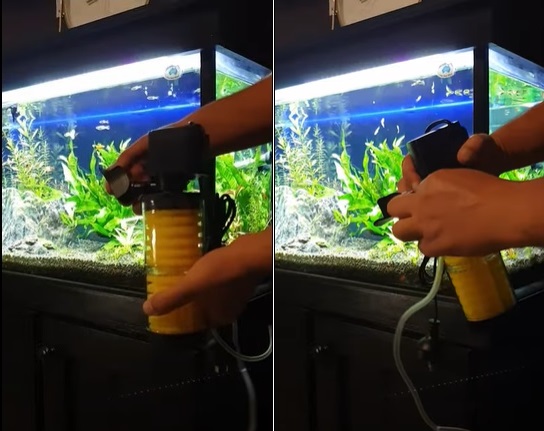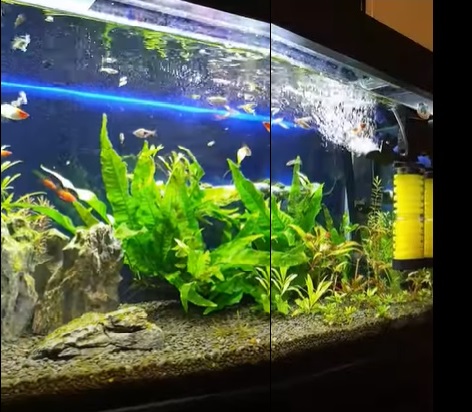How to unbox & setup an aquarium internal (submersible) filter:
Every fish tank needs a quality filter for mechanical filtration because they trap fish poop, dirt, & other debris from aquarium water. Aquarium filters can provide biological filtration as well because they remove toxic chemicals released from fish waste, & other decaying matter. Also, they are used for chemical filtration because they wipe out dangerous chemicals in water such as leftover medications, heavy metals, tannins from driftwood etc.
Aquarium internal filters are very popular in the fish hobby, & instead of being placed in cabinets or hanging on the back against the tank glass, they are setup inside the aquariums. Internal filters are setup against the tank glass using suction cups that hold the weight of the filter. They are relatively cheaper than other types of filters, & need simple setup & low maintenance.
Why internal filters are very important for filtration:
A filter is required for cleaning your aquarium & keeping your fish healthy. If you have many fish in your aquarium then it means that they will poop more so filter is required for cleaning their waste. Aquarium internal filters are very basic & widely sold units & they are useful if you can’t keep a filter outside a fish tank due to shortage of space. You can install an internal filter against the tank glass & position the outlet of the filter towards the water surface for water circulation.
A filter can’t perform without the media that traps toxic solid particles in the water, & only allows clean water to leave the filter. If you are using the top filtration media then it will efficiently clean your aquarium water.
Sobo FF-902 submersible filter specifications:
FF-902 is preloaded with 2 sponges. They are used for both mechanical & biological filtration.
Category | Rating |
Brand | SOBO |
Model No. | FF-902 |
Type | Power |
Type of Filtration | Mechanical |
Flow Direction | Adjustable |
Max. Flow Per Hour | 800 L/H |
Pump Included | Yes |
Benefits of an aquarium internal filter:
- Internal filters are made of high-quality material that is safe for the health of fish & water.
- They can run continuously for low power consumption & they have a long life.
- An adjustable air flow plate can allow you to choose the direction of water flow & air flow.
- They can be used for oxygenation, circulation & filtration of water.
- They can be simply disassembled for maintenance.
- Internal filters offer both mechanical & biological filtration.
- They must be completely submerged in water.
- Fish like to swim against the water currents generated by the internal filters.
- Waves created by internal filters imitate a wild habitat of fish like rivers & streams.
How to unbox & setup an internal filter:
Unboxing & setting up a submersible power filter
Step 1: Unboxing an aquarium submersible filter:
Take out the filter & all components from the box. In the box of Sobo FF-902, you will find an internal filter preloaded with 2 sponges, an air tube & an adjustable air flow plate.
Step 2: Attaching an air tube & an adjustable air flow plate:
Attach an adjustable air flow plate to the filter head that lets you decide the direction of air flow & water flow. Attach an air tube to the head of the filter for addition of atmospheric oxygen in the water. Put the other end of the air tube outside water. You can point the adjustable air flow plate either upward or downward. Install a filter close to the water surface. Point it upward towards the water surface for oxygenation & water circulation.
Disassembling an internal power filter:
I have disassembled an internal filter to show you the 2 sponges that are preloaded in the filter. Internal filters usually do not need any extra foam because it already offers high quality sponges for trapping fish waste, leftover food & other debris. Sponges can also offer biological filtration because they provide lots of surface area for the growth of good bacteria.
Testing an internal filter:
It is time to test the filter efficiency by installing it inside the aquarium against the glass using suction cups that will hold the filter in place. If you are not seeing the air bubbles coming out of the filter then it means either you have not connected the air tube to the filter head or the open end of the air tube is not placed outside water.
Internal filters are located inside the fish tanks so they are not consuming space outside of the aquariums, & they do not require installation of both inflow & outflow pipes, & both hoses (used for movement of water between fish tank & filter).
Internal filters normally take up small space in your tank which make them suitable for fish tank use.
How aquarium internal filters can aerate & circulate water:
Circular patterns of water flow in the fish tank can help oxygenate dead spots in your aquarium. If you point your filter adjustable air flow plate towards the surface then it will help in water circulation & will catch fish poop, remaining food & other debris by forcing them to leave the tank substrate & then they will be trapped by the filter.
Angling up your internal filter adjustable air flow plate will break the surface tension & create waves. It will oxygenate water. If you have installed your internal filter towards the left side of your aquarium then it will force water from left to right towards the surface & will attract water from the bottom right towards the left which will force fish waste & other debris to leave the substrate & they will be trapped by the filter. It will cause water to flow in a circular pattern in your fish tank.
How surface agitation can aerate water:
Warnings:
If the intake of internal filters has collected debris, then it will lower your filter performance. If you need reduced water flow then make adjustments to the flow control.
Do not operate internal filters emersed or fully out of water.
Always run the filter continuously but for maintenance make sure you unplug before taking the filter out of the water.
When you clean the sponge then quickly install it back in the filter because good bacteria growing on the sponge can’t live outside water so do not let your sponge dry out because it will lose beneficial bacteria too.
Do not use tap water for cleaning sponge because it will wipe out all beneficial bacteria on the sponge. Always use water from the aquarium for cleaning sponge.
Many aquarists only use filters for filtration. It is very important to use the other 2 features of the filters such as circulation & oxygenation of water.
Summary:
Aquarium internal filters are very handy because they can offer three functions: filtration, oxygenation & circulation. Internal filters consume less power, run continuously & clean aquarium water efficiently. They are installed inside the fish tank so they are not taking up any space outside of the fish tank & do not need a tedious setup for both intake & outtake pipes, & both hoses for movement of water between aquarium & filter. They usually take up a small space inside your aquarium which make them very convenient for aquarium use.








Post a Comment